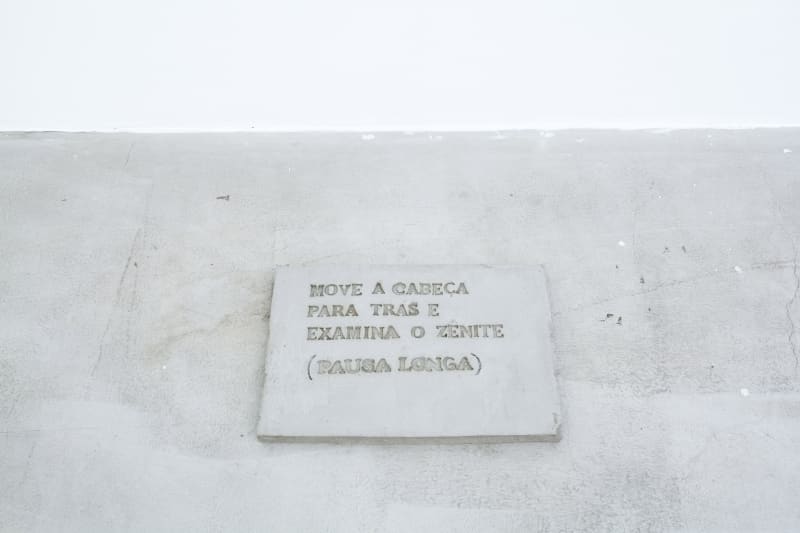Questionings about places
The Zip'Up Room is now bathed in a celestial light, emitting a glow that passes through the small side windows of the architectural niche that currently houses the acoustic artwork Ela Caminha em Direção à Fronteira (She Walks toward the Frontier). This is also the title of the solo exhibition of São Paulo artist Ana Mazzei, raising the curtain on the 2012 season of project Zip’Up. This virtual lighting pervades the walls, ceilings and structure of the building, which at one time housed Pietro Maria Bardi’s Mirante das Artes gallery, and spreads through the highly permeable building designed by Marcelo Rosenbaum.
“Tilt your head back and examine the zenith (long pause)”. This sentence, formulated by Beckett, is inscribed on a concrete plaque, suggesting courses for reading the artistic proposal offered by Mazzei. It is worth highlighting this open character of the artist’s exhibition, which, through the compilation of small items, things and elements, creates a praise of micronarratives, of short stories, supported by somewhat wandering itineraries, arranged on sliding territories.
“The man faces her and repeats the same question / ‘What did you say?’ / The woman turns and repeats / ‘Nothing’.” The passage from the acoustic work She Walks toward the Frontier brings something of Beckett’s drama, Ionesco’s absurdness, but also of the ruptures in space and time of the daring filmmaking of Resnais, Tarkovski and Lynch. Housed in a metal box, with residual touches, the narrative of characters free of attitudes and logical, given locations reverberates around the set of ten other elements arranged in relative proximity, in a white cube-style exhibition room. The mistaken path taken by the character who keeps repeating the phrase "She walks towards the frontier" echoes around the universe gathered and brought to the fore by Mazzei.
Right at the entrance, a concrete object (or sculpture?) consists of a kind of rosary, like the trace of a more secluded action. Flanked by small greyish modules, squares on the wall positioned higher than paintings of an exhibition. Grey, coiled fringes are embedded in a rectangular structure on the same wall.
It’s impossible not to recall Marcel Broodthaers (1924-1976), declared influence on the São Paulo artist in developing this installation setting. “Today, this poetic, fluctuating and often ironic interaction with objects of ‘art’ and ‘non-art’, with the false and the fetish, with words and meanings, with fiction and reality, as a rule can be found in contemporary artwork, in São Paulo as well as other places in the world. An increasing interest has emerged in the categories that were so fundamental to Broodthaers’ work: systems and fictional systems of order, such as the museum, the archive, the library, the collection, but also the book, text and letters”1, states the art critic and curator Jochen Volz on the present relevance of the Belgian artist.
In a way, Mazzei generates noisy frictions to present her artistic process, broader than that of the paintings that made her a familiar name on the São Paulo circuit. There is no lack of pictorial discussion, but that is part of the relations created in this setting. The five small black paintings have a specular aspect, but are mirrors that do not reflect what we expect. The combination of various techniques and undefined figuration – we can see dogs, people, landscapes, but the paint matter shelters deformed volumes – results in unstable forms like those of Espelho Cego [Blind Mirror] (1970) by Cildo Meireles, or that of François, protagonist of the feature film Frontier of Dawn (2008) by Philippe Garrel, gazing into the mirror in his room and recognizing, in a mixture of horror and fascination, his beloved Carole in post-death.
She Walks toward the Frontier is dotted with Lacanian slips of the tongue, especially when we come across the small bronze statue, on the floor and in pieces. “All that is real is always and obligatorily in its place, even when it is disturbed. The real has the property of carrying its place in the sole of its shoes. You can mess the real up as much as you like, but our bodies will still be in their place after the explosion of an atom bomb, in their place of pieces. The absence of something in the real is purely symbolic”2, asserts the French thinker. The same observation can be applied to the other three-dimensional piece, of delicate, short lines, that can equally evoke ideas of handcuffs or the symbol for infinity, but somewhat displaced and frayed - even more so because it is positioned in isolation on a white wall. “Art has always had something to do with correspondence, especially the correspondence between the image and its reproduction, between a word and its meaning, between fiction and reality, between art and life”3, maintains Dorothea Zwirner in relation to Broodthaers' work. Today, Ana Mazzei skillfully offers us correspondences to be completed, the meanings of which never fail to provoke new enigmas and questions.
Mario Gioia
1. LAGNADO, Lisette (org.). 27th São Paulo Bienal – Seminars. Fundação Bienal de São Paulo/ Cobogó, São Paulo, 2006, p. 24
2. LACAN, Jacques. O Seminário, Livro 4 – A Relação de Objeto. Jorge Zahar, Rio de Janeiro, 1995, p. 98
3. LAGNADO, Lisette (org.). Idem, p. 75

